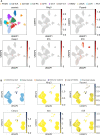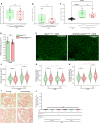No NLRP3 inflammasome activity in kidney epithelial cells, not even when the NLRP3-A350V Muckle-Wells variant is expressed in podocytes of diabetic mice
- PMID: 37744356
- PMCID: PMC10513077
- DOI: 10.3389/fimmu.2023.1230050
No NLRP3 inflammasome activity in kidney epithelial cells, not even when the NLRP3-A350V Muckle-Wells variant is expressed in podocytes of diabetic mice
Abstract
Background: The NLRP3 inflammasome integrates several danger signals into the activation of innate immunity and inflammation by secreting IL-1β and IL-18. Most published data relate to the NLRP3 inflammasome in immune cells, but some reports claim similar roles in parenchymal, namely epithelial, cells. For example, podocytes, epithelial cells critical for the maintenance of kidney filtration, have been reported to express NLRP3 and to release IL-β in diabetic kidney disease, contributing to filtration barrier dysfunction and kidney injury. We questioned this and hence performed independent verification experiments.
Methods: We studied the expression of inflammasome components in human and mouse kidneys and human podocytes using single-cell transcriptome analysis. Human podocytes were exposed to NLRP3 inflammasome agonists in vitro and we induced diabetes in mice with a podocyte-specific expression of the Muckle-Wells variant of NLRP3, leading to overactivation of the Nlrp3 inflammasome (Nphs2Cre;Nlrp3A350V) versus wildtype controls. Phenotype analysis included deep learning-based glomerular and podocyte morphometry, tissue clearing, and STED microscopy of the glomerular filtration barrier. The Nlrp3 inflammasome was blocked by feeding ß-hydroxy-butyrate.
Results: Single-cell transcriptome analysis did not support relevant NLRP3 expression in parenchymal cells of the kidney. The same applied to primary human podocytes in which NLRP3 agonists did not induce IL-1β or IL-18 secretion. Diabetes induced identical glomerulomegaly in wildtype and Nphs2Cre;Nlrp3A350V mice but hyperfiltration-induced podocyte loss was attenuated and podocytes were larger in Nphs2Cre;Nlrp3A350V mice, an effect reversible with feeding the NLRP3 inflammasome antagonist ß-hydroxy-butyrate. Ultrastructural analysis of the slit diaphragm was genotype-independent hence albuminuria was identical.
Conclusion: Podocytes express low amounts of the NLRP3 inflammasome, if at all, and do not produce IL-1β and IL-18, not even upon introduction of the A350V Muckle-Wells NLRP3 variant and upon induction of podocyte stress. NLRP3-mediated glomerular inflammation is limited to immune cells.
Keywords: IL-1; chronic kidney disease; diabetes; inflammasome; inflammation; proteinuria.
Copyright © 2023 Kunte, Marschner, Klaus, Honda, Li, Motrapu, Walz, Angelotti, Antonelli, Melica, De Chiara, Semeraro, Nelson and Anders.
Conflict of interest statement
The authors declare that the research was conducted in the absence of any commercial or financial relationships that could be construed as a potential conflict of interest.
Figures






Similar articles
-
Podocyte-specific silencing of acid sphingomyelinase gene to abrogate hyperhomocysteinemia-induced NLRP3 inflammasome activation and glomerular inflammation.Am J Physiol Renal Physiol. 2024 Jun 1;326(6):F988-F1003. doi: 10.1152/ajprenal.00195.2023. Epub 2024 Apr 18. Am J Physiol Renal Physiol. 2024. PMID: 38634138 Free PMC article.
-
[Triptolide inhibits NLRP3 inflammasome activation and ameliorates podocyte epithelial-mesenchymal transition induced by high glucose].Zhongguo Zhong Yao Za Zhi. 2019 Dec;44(24):5457-5464. doi: 10.19540/j.cnki.cjcmm.20191114.401. Zhongguo Zhong Yao Za Zhi. 2019. PMID: 32237395 Chinese.
-
Inhibition of NLRP3 inflammasome ameliorates podocyte damage by suppressing lipid accumulation in diabetic nephropathy.Metabolism. 2021 May;118:154748. doi: 10.1016/j.metabol.2021.154748. Epub 2021 Mar 4. Metabolism. 2021. PMID: 33675822
-
Inflammasome activation in podocytes: a new mechanism of glomerular diseases.Inflamm Res. 2020 Aug;69(8):731-743. doi: 10.1007/s00011-020-01354-w. Epub 2020 May 24. Inflamm Res. 2020. PMID: 32448973 Review.
-
CAPS and NLRP3.J Clin Immunol. 2019 Apr;39(3):277-286. doi: 10.1007/s10875-019-00638-z. Epub 2019 May 10. J Clin Immunol. 2019. PMID: 31077002 Free PMC article. Review.
Cited by
-
The role of intercellular communication in diabetic nephropathy.Front Immunol. 2024 Aug 22;15:1423784. doi: 10.3389/fimmu.2024.1423784. eCollection 2024. Front Immunol. 2024. PMID: 39238645 Free PMC article. Review.
-
Podocyte A20/TNFAIP3 Controls Glomerulonephritis Severity via the Regulation of Inflammatory Responses and Effects on the Cytoskeleton.Cells. 2025 Mar 5;14(5):381. doi: 10.3390/cells14050381. Cells. 2025. PMID: 40072109 Free PMC article.
-
Interferon-γ induces combined pyroptotic angiopathy and APOL1 expression in human kidney disease.Cell Rep. 2024 Jun 25;43(6):114310. doi: 10.1016/j.celrep.2024.114310. Epub 2024 Jun 4. Cell Rep. 2024. PMID: 38838223 Free PMC article.
-
Targeting the Type I Interferon Pathway in Glomerular Kidney Disease: Rationale and Therapeutic Opportunities.Kidney Int Rep. 2024 Oct 21;10(1):29-39. doi: 10.1016/j.ekir.2024.10.013. eCollection 2025 Jan. Kidney Int Rep. 2024. PMID: 39810777 Free PMC article. Review.
-
The NLRP3 inflammasome in burns: a novel potential therapeutic target.Burns Trauma. 2024 Jul 2;12:tkae020. doi: 10.1093/burnst/tkae020. eCollection 2024. Burns Trauma. 2024. PMID: 38957662 Free PMC article. Review.
References
Publication types
MeSH terms
Substances
LinkOut - more resources
Full Text Sources
Molecular Biology Databases
Miscellaneous

